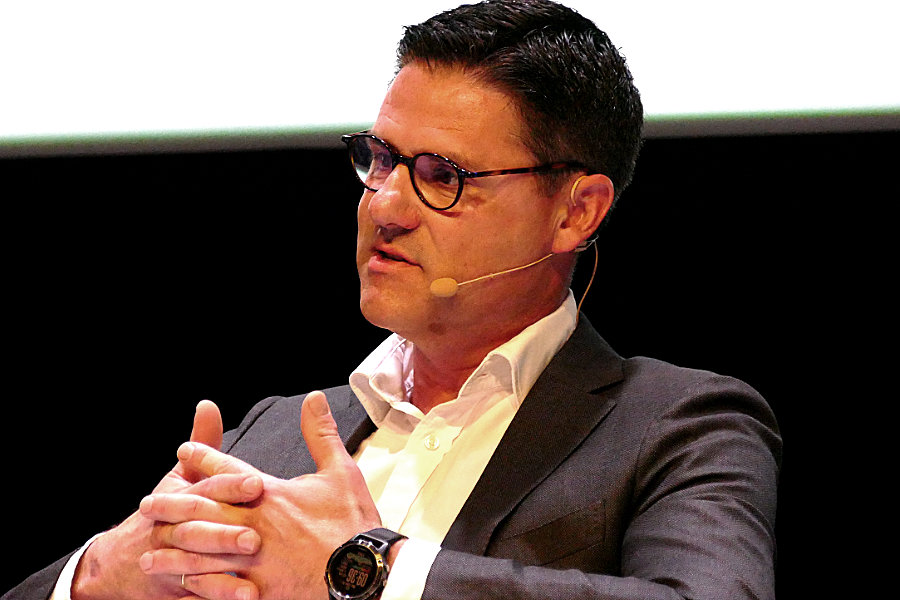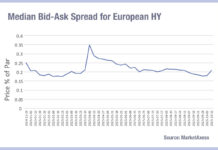A new white paper from exchange traded fund (ETF) market maker, Flow Traders, estimates that in the past two to three years, credit algos have made up around 50% of executed volumes in Euro investment grade (IG) credit, with the creates effect in the sub €1 million ticket sizes. It finds that 20% of overall fixed income trading was executed via algorithms.
According to anecdotal reports to The DESK, ETF market makers dominate smaller-sized trades while larger banks – often US firms – dominate larger trade sizes.

“As the relationship with the dealer becomes increasingly focused on the more complex trades, for example larger sizes or less liquid instruments, and less on the execution of the low-touch trades, there is a growing number of buy-side participants adopting a combination of low-touch and high-touch execution models,” wrote the authors, including Ramon Baljé, head of fixed income EMEA at Flow Traders. “Within the high-touch trading styles, the buy-side use enhanced pre-trade analytics to determine dealer selection. Flow Traders believes that historical dealer performance metrics could still be utilised in a better manner on a dealer-to-counterparty and ISIN-by-ISIN basis, with a more unified process being adopted across the venues. For low-touch styles and protocols such as MarketAxess’ Open Trading (OT), studies conducted outline that if more dealers are included in a request, it results in more responses. This is even with OT included and improves trade cost analysis (TCA).”
Flow Traders estimates that there are over 15 sell-side algos active in Euro credit today, with varying degrees of sophistication. Some of the more advanced algos can automatically price the full range of Euro IG (around 5K) ISINs as well as the larger sizes for the more liquid parts of the universe.
In Q4 of 2022, the firm reports that the top five average quoting times on Tradeweb for all sizes of Euro corporate bonds was under six seconds.
In Europe, bond pricing sources are extremely fragmented, the firm observes, and as there is no pricing consensus coming from a CT, bond traders face the challenge of the need to consolidate various pricing information sources in a quick and efficient manner. The use of algos allows them to potentially collect, aggregate and interpret pricing determinants and translate them to a competitive pricing in seconds.
“In European credit, we see a clear correlation between responses and pricing outcomes, a similar result to our US IG analysis,” wrote the report team. “The average TCA versus number of responses, saw each additional response improving TCA by ~1.2 cents. TCA outcomes are strongly correlated with realized responses, as we see a linear correlation co-efficient (R-squared) >95%. In 2022, European credit RFQs that received ten or more responses outperformed Composite+™ bid/offer, while over ~44% of trades received at least ten responses and outperformed Composite+ side. TCA is defined relative to Composite+ and is calculated as the difference between the trade price and the Composite+ price on the corresponding side, at inquiry time. A positive value means the trade occurred inside (more competitive than) Composite+ bid or offer, while a negative value means the trade occurred outside (less competitive than) the Composite+ bid or offer.”
ETF market makers like Flow Traders are major drivers of this development as they use algorithmic strategies for ETF liquidity and have been adjusting these mechanisms to achieve the same sort of efficiencies in the underlying bond markets.
“Whilst fixed income UCITS ETF assets under management (AUM) currently make up only a small part of the European fixed income market, ETFs are growing in importance,” wrote the report’s authors. “This is in part due to the additional layer of liquidity that these ETFs provide, on top of the underlying cash bond market. Blackrock iShares suggests that secondary trading volumes in Euro IG and HY ETFs during the first half of 2022 were equivalent to almost 8% of the underlying bond market volumes, up from 4% in 2018. Additionally, Euro credit ETF volumes increased by 25% in 2022, this trend is replicated globally. This is also more prominent in the U.S. market, where credit ETF trading volumes increased to 26% of the underlying bond market volumes, up from 11% in 2018.”
The report tracked five trends in the fixed income market: electronification; new drivers of liquidity; changes in Euro IG credit market structure; the rise of low-touch and high-touch trading styles; and an increased focus on transparency.
It found that activity within the smaller ticket sizes has an impact on the overall Euro IG credit market structure, as the sub €1 million ticket size buckets now contribute a significant majority of tickets, making up 87% of all tickets up from 83% in 2021 at the expense of almost every other bucket.
The firm’s research indicates that the percentage of trades within this ticket size increased to 29% of traded volume in 2022, compared to 27% in 2021 and 23% in 2018.
At the same time, the €1-2.5 million and €2.5-5 million ticket sizes were relatively unchanged in terms of volumes in 2022 versus 2021.
Volume of block trades of €5-10 million and €10-50 million ticket sizes, however, decreased as part of an ongoing trend.
“It is fair to say that automated trading has accelerated in certain parts of fixed income, particularly in Euro IG, where Flow Traders estimates that 50% of the electronic flow is now traded by automated strategies,” concluded the report. “This has led to new liquidity dynamics and styles of trading, especially in smaller size tickets. All these developments have led to new execution business models being adopted by the buy-side. Low-touch execution styles for the smaller tickets in Euro IG are often fully automated and there are clear TCA advantages in adding more dealers, or including [MarketAxess] Open Trading, A2A or [Bloomberg] Bridge. This is contrary to common belief that one should limit to only a few axed dealers due to information leakage issues. For the larger size tickets, or less liquid names a more high-touch approach is beneficial with increased focus on pre-trade analysis, such as looking at axes, dealer performance and relationships. For portfolio trading, new platform innovations like ETF overlap tools, benchmark trading, and new asset classes, particularly in EM portfolio trading are clear signs of the further maturing protocol. These innovations amongst others have led to more efficient dealer relationships and to growth in for example, EM portfolio trading on and off venues.”
©Markets Media Europe 2023
©Markets Media Europe 2025
















